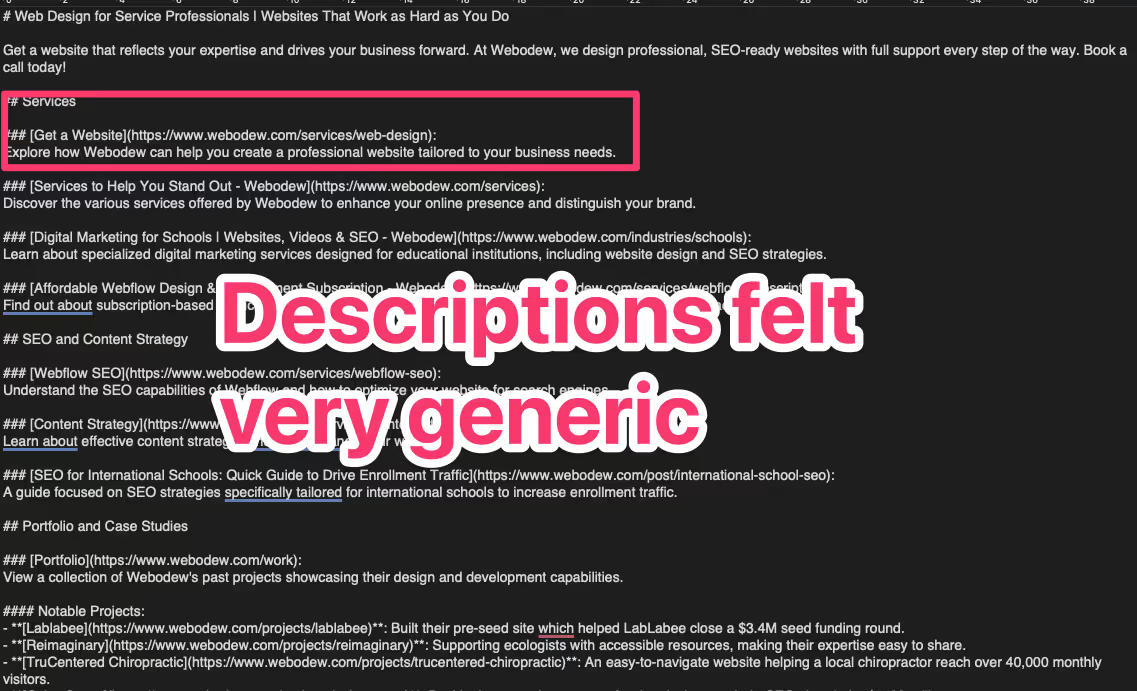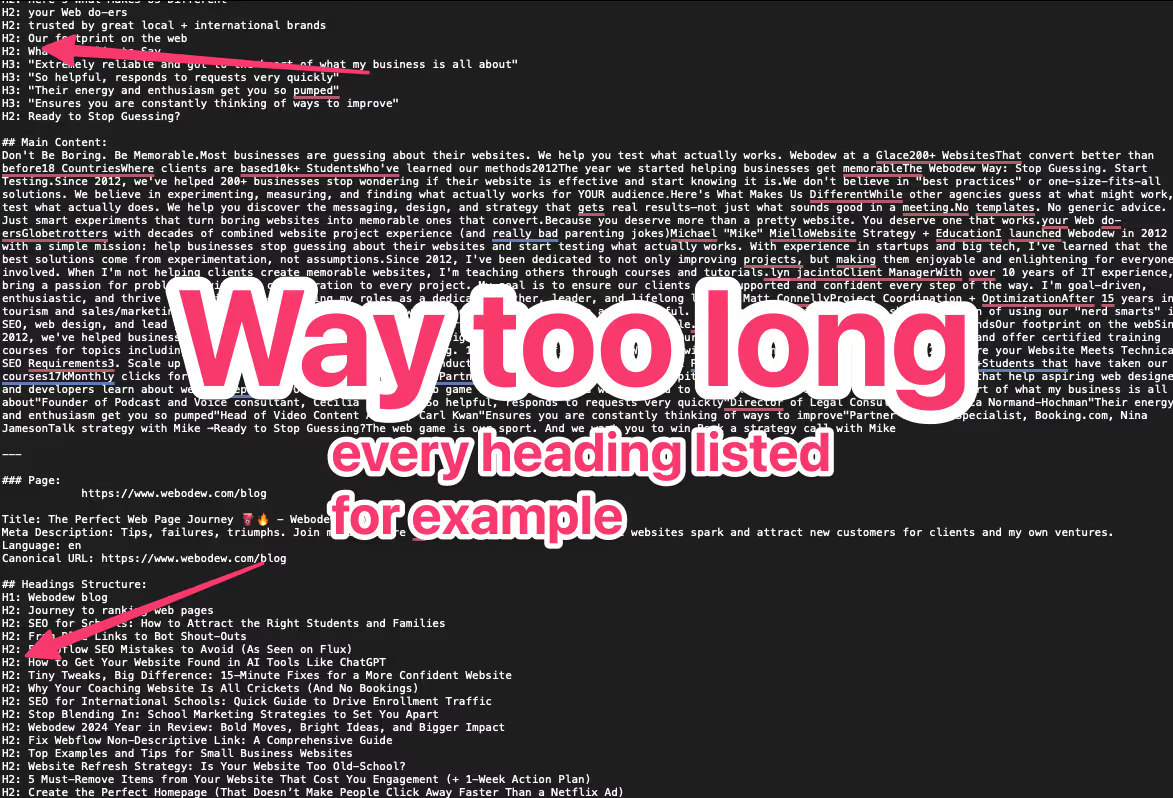Picture this: someone asks ChatGPT for a recommendation in your industry, and your competitor gets mentioned while you don't even show up on the radar.
Frustrating?
Absolutely. But here's what's really wild - 43% of people now use AI search tools like ChatGPT or Gemini daily or more, and most businesses have no idea they're missing out on an entirely new way people discover services.
I'd been hearing more about LLMS.txt files and AI optimization, but honestly hadn't prioritized testing it yet since Webflow didn't have this baked into their platform.
Then Webflow announced they're now supporting LLMS.txt files directly in their site settings, which made me think - okay, if they're making it this easy, I should probably take action!
So I decided to test it out. I used two different LLMS.txt generators since Webflow doesn't do this automatically and wow - the results were completely different. One was basic, the other was maybe too comprehensive.
Neither felt right to me because I'm a big fan of finding the balance between being concise and detailed enough to demonstrate uniqueness And so I wanted to share my process because I think this can actually help people feed AI tools the information they want about his or her business. And in doing so, this can help your business show up in AI results.
What Is LLMS.txt and Why Should You Care?
Think of LLMS.txt as your website's resume for AI tools. When someone asks ChatGPT or Claude about services like yours, these tools can reference your LLMS.txt file to understand exactly what you do, who you serve, and why you're the right choice.
The potential here is huge. Instead of just hoping people find you through Google searches, you can now be directly recommended by AI assistants that millions of people trust for advice.
For service professionals and schools, this is a game-changer. When someone asks an AI tool for recommendations, you want to be the name that comes up.
I tested 2 LLMs.txt Generators
I decided to test this by generating LLMS.txt files using two different tools:
- WriteSonic's LLM generator: Super minimal output - barely covered the basics
- SitemapTo-LLM generator: Went completely overboard - way too much information
The difference was shocking.
One file was like a business card with just your name, while the other was like dumping your entire filing cabinet on someone's desk.


I turned to Claude for guidance and it changed how I approached AI optimization.
The Best Practices That Actually Work
After working with Claude to optimize my LLMS.txt file, here are the golden rules I discovered:
1. Find the Sweet Spot for Length
Your LLMS.txt file should be comprehensive enough to be useful but focused enough to be digestible. Think 1,500-2,500 words max. Any shorter and you're missing opportunities. Any longer and AI tools might struggle to process the key information quickly.
2. Lead with Your Core Value Proposition
Start your file with a crystal-clear explanation of what you do and who you serve. Don't bury the lead in company history or mission statements.
Good example:
Webodew - Professional Webflow Design & SEO Services
Custom Webflow websites and SEO optimization for service professionals,
international schools, and SaaS companies who need websites that generate
real business results.
3. Include the Human Behind the Business
Here's something most people miss: AI tools love to recommend specific people, not just faceless companies. Include details about the business owner or key team members. This personal touch makes your business more memorable and trustworthy.
I specifically asked Claude to add information about me as the founder because people want to know who they're working with, especially for service businesses.
4. Structure for AI Consumption
Use clear headers and logical sections. AI tools process structured information much better than walls of text. Break your content into sections like:
- Company Overview
- Core Services
- What Makes You Different
- Client Results & Case Studies
- Target Clients
- Problems You Solve
5. Focus on Outcomes, Not Just Features
Instead of just listing what you do, explain the results you deliver. AI tools are great at matching user needs with solution providers, so give them specific outcomes to work with.
Instead of: "We do SEO optimization"Try: "SEO optimization that helps clients achieve 3x traffic increases and rank #1 for target keywords"
How to Set Up LLMS.txt in Webflow
The technical setup is actually the easy part. Here's how to do it:
- Create your LLMS.txt file following the best practices above
- Log into your Webflow project
- Go to Project Settings > SEO Tab
- Upload your LLMS.txt file in the new section Webflow added
- Publish your site to make it live
That's it! Your file will be accessible at yoursite.com/llms.txt for AI tools to reference.
Common Mistakes That Kill Your AI Visibility
After reviewing dozens of LLMS.txt files, here are the biggest mistakes I see:
Mistake #1: Generic Business Descriptions
Don't sound like every other company in your space. What makes you specifically different and better?
Mistake #2: Missing Client Results
AI tools love recommending businesses with proven track records. Include specific numbers and outcomes.
Mistake #3: Forgetting Your Target Audience
Be crystal clear about who you serve. "Small businesses" isn't specific enough. Try "busy marketing teams at service-based businesses who need websites that actually convert visitors to clients."
Mistake #4: Skipping the Personal Touch
People buy from people. Include information about the founder or key team members.
Mistake #5: Information Overload
More isn't always better. Focus on the most important information that helps AI tools understand when to recommend you.
Testing Your LLMS.txt Effectiveness
Here's how I test whether my LLMS.txt file is working:
- Ask AI tools directly: "Can you recommend a Webflow designer who specializes in SEO?"
- Monitor your referral traffic: Check Google Analytics for any upticks in direct traffic
- Track mention requests: See if people mention finding you through AI recommendations
The goal isn't just to have the file - it's to be the business that gets recommended when someone asks for help in your area.
Advanced Webflow AI SEO Strategies
Beyond LLMS.txt, here are other ways to optimize your Webflow site for AI discovery:
Schema Markup Integration
Webflow makes it easy to add structured data that helps both Google and AI tools understand your content better. Focus on:
- Organization schema
- Service schema
- Local business schema (if applicable)
- Review schema for testimonials
Content Optimization for AI
Write your website content with AI consumption in mind. Use clear, descriptive language and include the specific problems you solve and results you deliver.
Regular Content Updates
AI tools favor current, relevant information. Keep your site updated with fresh case studies, client results, and industry insights.
Why This Matters More Than You Think
We're still in the early days of AI search optimization. The businesses that figure this out now will have a massive advantage as AI tools become the default way people research and make decisions.
For Webflow SEO services, this is especially important because Webflow sites are already well-structured for both traditional and AI search optimization.
Think about it: when someone asks ChatGPT for a recommendation in your industry, do you want to be the business that gets mentioned? Or do you want to be the one wondering why your competitors are getting all the AI-driven leads?
What's Next for AI Search Optimization
The LLMS.txt file is just the beginning. As AI tools get smarter and more widely adopted, we'll see new ways to optimize for AI discovery. But the fundamentals will remain the same:
- Clear, specific value propositions
- Proven results and social proof
- Well-structured, comprehensive information
- Personal touches that build trust
The businesses investing in AI SEO strategies now will be the ones dominating AI recommendations in the future.
Ready to Optimize Your Webflow Site for AI Tools?
Creating an effective LLMS.txt file is just one piece of the AI optimization puzzle. If you want your Webflow site to be found and recommended by AI tools, you need a comprehensive strategy that includes technical optimization, content strategy, and structured data implementation.
The good news? Webflow's platform makes it easier than ever to implement these optimizations correctly. But knowing what to optimize and how to do it effectively - that's where experience makes all the difference.
Want to ensure your website is ready for the AI search revolution? Let's talk strategy and make sure you're positioned to capture AI-driven leads before your competitors figure it out.
FAQs
An LLMS.txt file is a structured text file that helps AI tools like ChatGPT and Claude understand your business better. When someone asks these tools for recommendations, they can reference your LLMS.txt file to get accurate information about what you do, who you serve, and why you're a good choice. Think of it as your elevator pitch specifically written for AI consumption.
Super simple! Log into your Webflow project, go to Project Settings > SEO Tab, and you'll see a new section where you can upload your LLMS.txt file. Once you publish your site, the file will be accessible at yoursite.com/llms.txt for AI tools to find and use.
Aim for 1,500-2,500 words. Any shorter and you're missing opportunities to showcase what makes you unique. Any longer and AI tools might struggle to process the key information quickly. Focus on quality over quantity - make every section count.
It definitely increases your chances of being recommended! AI tools use various sources to make recommendations, and having a well-structured LLMS.txt file gives them clear, accurate information about your business. While there's no guarantee, I've seen businesses start getting mentioned in AI responses after implementing their files correctly.
Not at all! LLMS.txt files are completely separate from traditional SEO factors. Google doesn't use these files for ranking purposes, so there's no risk to your existing search performance. It's purely additive - you're just giving yourself another way to be discovered.



